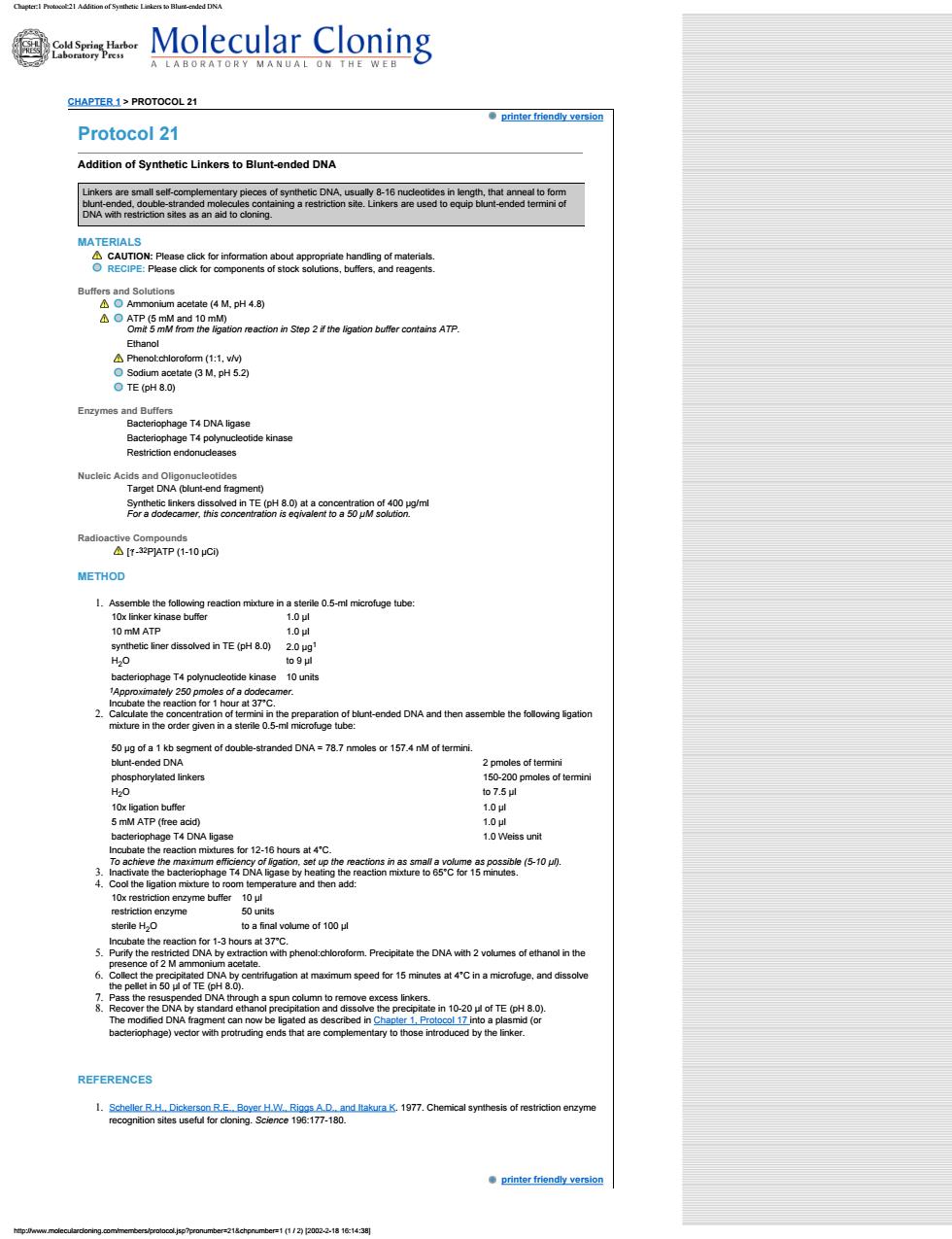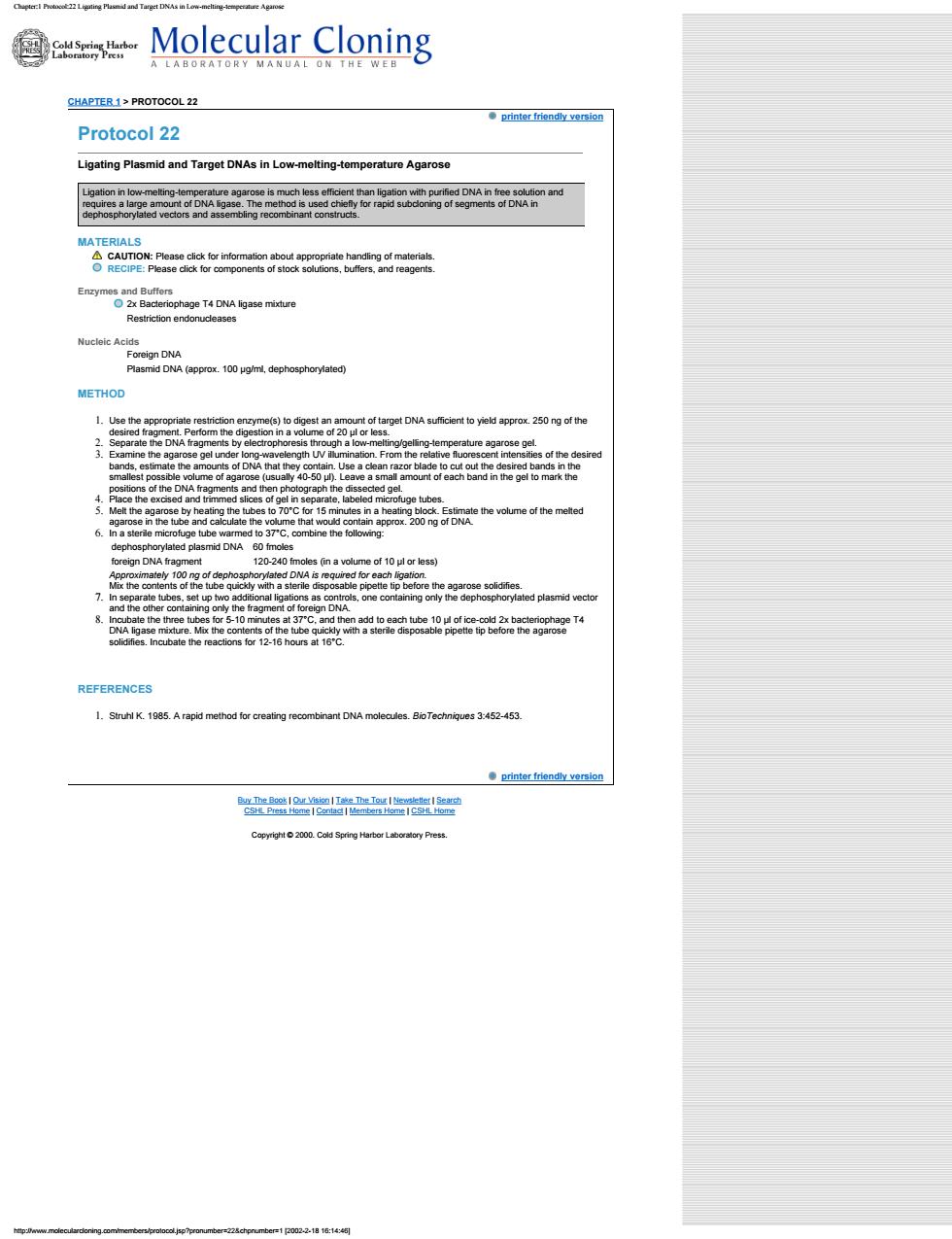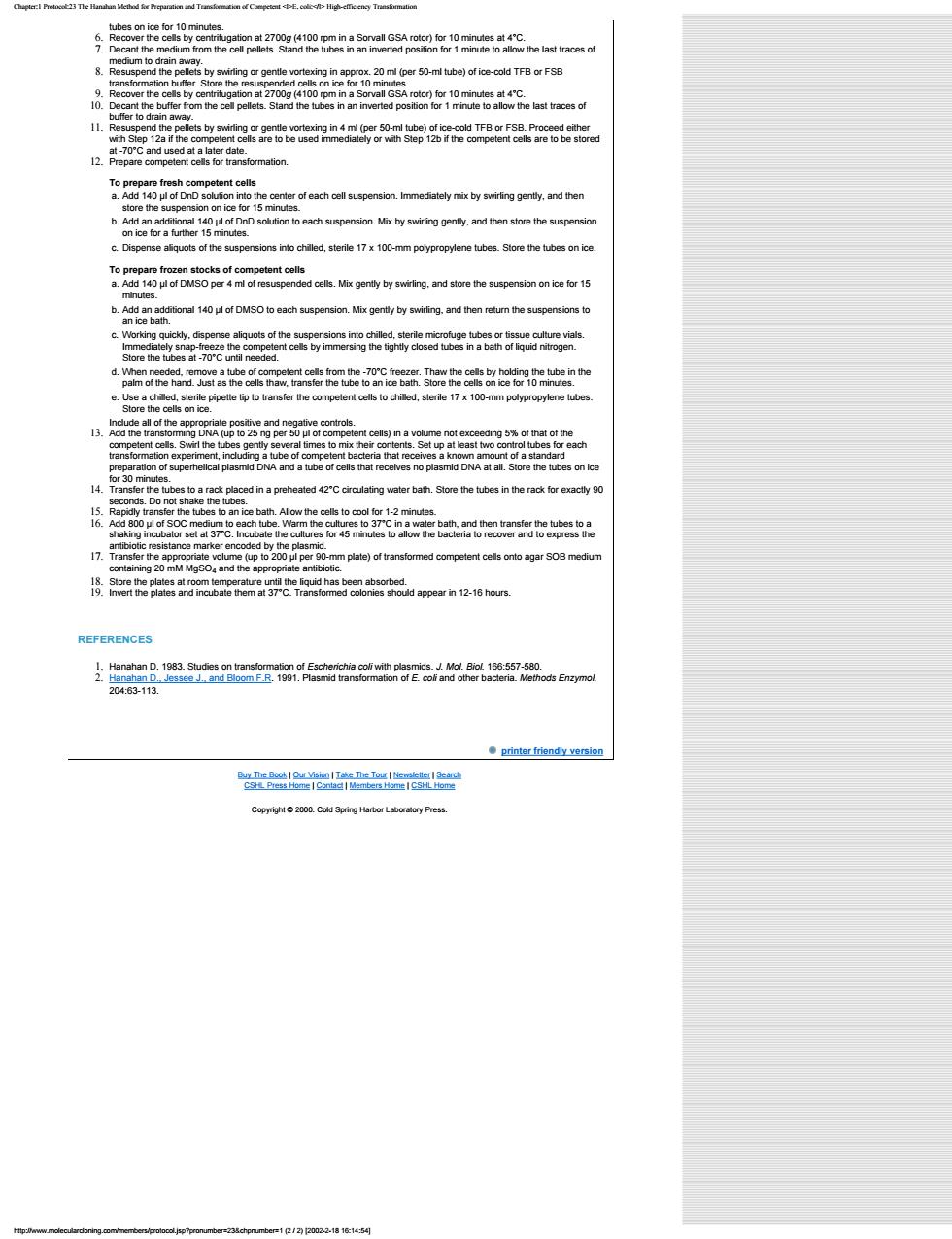
eo Copyright2000.Cold Soing Harbor Lsboratery Press
Chapter:1 Protocol:20 Dephosphorylation of Plasmid DNA bacteria of structural gene for rat growth hormone. Nature 270:486-494. 2. Ullrich A., Shine J., Chirgwin J., Pictet R., Tischer E., Rutter W.J., and Goodman H.M. 1977. Rat insulin genes: Construction of plasmids containing the coding sequences. Science 196:1313-1319. printer friendly version Buy The Book | Our Vision | Take The Tour | Newsletter | Search CSHL Press Home | Contact | Members Home | CSHL Home Copyright © 2000. Cold Spring Harbor Laboratory Press. http://www.molecularcloning.com/members/protocol.jsp?pronumber=20&chpnumber=1 (2 / 2) [2002-2-18 16:14:29]

Molecular Cloning L A BO R A T OR Y Protocol 21 Addition of Syntheti ersto Blunt-ended DNA reaction in Step 2 the ligation buffer contains ATP TE (pH8.0) Enzymes and Buffers aenfncenT正g8aegn000on aTP(10C METHOD e the fo le 0.5-m microfuge tube ssolved in TE (pH 8.0)2 ,10 mble the following gphontbadnkam olume of 100 u henctehsroiormPrn e the DN the DNA by st a2020品E@ phage) EFERENCES Htakura K.1977.Che ●printer friendy versio
Chapter:1 Protocol:21 Addition of Synthetic Linkers to Blunt-ended DNA CHAPTER 1 > PROTOCOL 21 printer friendly version Protocol 21 Addition of Synthetic Linkers to Blunt-ended DNA Linkers are small self-complementary pieces of synthetic DNA, usually 8-16 nucleotides in length, that anneal to form blunt-ended, double-stranded molecules containing a restriction site. Linkers are used to equip blunt-ended termini of DNA with restriction sites as an aid to cloning. MATERIALS CAUTION: Please click for information about appropriate handling of materials. RECIPE: Please click for components of stock solutions, buffers, and reagents. Buffers and Solutions Ammonium acetate (4 M, pH 4.8) ATP (5 mM and 10 mM) Omit 5 mM from the ligation reaction in Step 2 if the ligation buffer contains ATP. Ethanol Phenol:chloroform (1:1, v/v) Sodium acetate (3 M, pH 5.2) TE (pH 8.0) Enzymes and Buffers Bacteriophage T4 DNA ligase Bacteriophage T4 polynucleotide kinase Restriction endonucleases Nucleic Acids and Oligonucleotides Target DNA (blunt-end fragment) Synthetic linkers dissolved in TE (pH 8.0) at a concentration of 400 µg/ml For a dodecamer, this concentration is eqivalent to a 50 µM solution. Radioactive Compounds [ -32P]ATP (1-10 µCi) METHOD 1. Assemble the following reaction mixture in a sterile 0.5-ml microfuge tube: 10x linker kinase buffer 1.0 µl 10 mM ATP 1.0 µl synthetic liner dissolved in TE (pH 8.0) 2.0 µg1 H2O to 9 µl bacteriophage T4 polynucleotide kinase 10 units 1Approximately 250 pmoles of a dodecamer. Incubate the reaction for 1 hour at 37°C. 2. Calculate the concentration of termini in the preparation of blunt-ended DNA and then assemble the following ligation mixture in the order given in a sterile 0.5-ml microfuge tube: 50 µg of a 1 kb segment of double-stranded DNA = 78.7 nmoles or 157.4 nM of termini. blunt-ended DNA 2 pmoles of termini phosphorylated linkers 150-200 pmoles of termini H2O to 7.5 µl 10x ligation buffer 1.0 µl 5 mM ATP (free acid) 1.0 µl bacteriophage T4 DNA ligase 1.0 Weiss unit Incubate the reaction mixtures for 12-16 hours at 4°C. To achieve the maximum efficiency of ligation, set up the reactions in as small a volume as possible (5-10 µl). 3. Inactivate the bacteriophage T4 DNA ligase by heating the reaction mixture to 65°C for 15 minutes. 4. Cool the ligation mixture to room temperature and then add: 10x restriction enzyme buffer 10 µl restriction enzyme 50 units sterile H2O to a final volume of 100 µl Incubate the reaction for 1-3 hours at 37°C. 5. Purify the restricted DNA by extraction with phenol:chloroform. Precipitate the DNA with 2 volumes of ethanol in the presence of 2 M ammonium acetate. 6. Collect the precipitated DNA by centrifugation at maximum speed for 15 minutes at 4°C in a microfuge, and dissolve the pellet in 50 µl of TE (pH 8.0). 7. Pass the resuspended DNA through a spun column to remove excess linkers. 8. Recover the DNA by standard ethanol precipitation and dissolve the precipitate in 10-20 µl of TE (pH 8.0). The modified DNA fragment can now be ligated as described in Chapter 1, Protocol 17 into a plasmid (or bacteriophage) vector with protruding ends that are complementary to those introduced by the linker. REFERENCES 1. Scheller R.H., Dickerson R.E., Boyer H.W., Riggs A.D., and Itakura K. 1977. Chemical synthesis of restriction enzyme recognition sites useful for cloning. Science 196:177-180. printer friendly version http://www.molecularcloning.com/members/protocol.jsp?pronumber=21&chpnumber=1 (1 / 2) [2002-2-18 16:14:38]

Molecular Cloning Protocol 22 Ligating Plasmid and Target DNAs in Low-meing-tomperaturegaroe MATERIALS 1.Use the mid DNA REFERENCES 1.nK1.Arapld mo inant DNA molecules.BloTechniques 3:452-453
Chapter:1 Protocol:22 Ligating Plasmid and Target DNAs in Low-melting-temperature Agarose CHAPTER 1 > PROTOCOL 22 printer friendly version Protocol 22 Ligating Plasmid and Target DNAs in Low-melting-temperature Agarose Ligation in low-melting-temperature agarose is much less efficient than ligation with purified DNA in free solution and requires a large amount of DNA ligase. The method is used chiefly for rapid subcloning of segments of DNA in dephosphorylated vectors and assembling recombinant constructs. MATERIALS CAUTION: Please click for information about appropriate handling of materials. RECIPE: Please click for components of stock solutions, buffers, and reagents. Enzymes and Buffers 2x Bacteriophage T4 DNA ligase mixture Restriction endonucleases Nucleic Acids Foreign DNA Plasmid DNA (approx. 100 µg/ml, dephosphorylated) METHOD 1. Use the appropriate restriction enzyme(s) to digest an amount of target DNA sufficient to yield approx. 250 ng of the desired fragment. Perform the digestion in a volume of 20 µl or less. 2. Separate the DNA fragments by electrophoresis through a low-melting/gelling-temperature agarose gel. 3. Examine the agarose gel under long-wavelength UV illumination. From the relative fluorescent intensities of the desired bands, estimate the amounts of DNA that they contain. Use a clean razor blade to cut out the desired bands in the smallest possible volume of agarose (usually 40-50 µl). Leave a small amount of each band in the gel to mark the positions of the DNA fragments and then photograph the dissected gel. 4. Place the excised and trimmed slices of gel in separate, labeled microfuge tubes. 5. Melt the agarose by heating the tubes to 70°C for 15 minutes in a heating block. Estimate the volume of the melted agarose in the tube and calculate the volume that would contain approx. 200 ng of DNA. 6. In a sterile microfuge tube warmed to 37°C, combine the following: dephosphorylated plasmid DNA 60 fmoles foreign DNA fragment 120-240 fmoles (in a volume of 10 µl or less) Approximately 100 ng of dephosphorylated DNA is required for each ligation. Mix the contents of the tube quickly with a sterile disposable pipette tip before the agarose solidifies. 7. In separate tubes, set up two additional ligations as controls, one containing only the dephosphorylated plasmid vector and the other containing only the fragment of foreign DNA. 8. Incubate the three tubes for 5-10 minutes at 37°C, and then add to each tube 10 µl of ice-cold 2x bacteriophage T4 DNA ligase mixture. Mix the contents of the tube quickly with a sterile disposable pipette tip before the agarose solidifies. Incubate the reactions for 12-16 hours at 16°C. REFERENCES 1. Struhl K. 1985. A rapid method for creating recombinant DNA molecules. BioTechniques 3:452-453. printer friendly version Buy The Book | Our Vision | Take The Tour | Newsletter | Search CSHL Press Home | Contact | Members Home | CSHL Home Copyright © 2000. Cold Spring Harbor Laboratory Press. http://www.molecularcloning.com/members/protocol.jsp?pronumber=22&chpnumber=1 [2002-2-18 16:14:46]

Molecular Cloning L A BO R A T OR Y ●printer friendy versio Protocol 23 Toohod mation of C i:High-officiency MATERIALS ffers (please see Step 1) Media hespropriaantee ant plasmid) METHOD etone3 per liter 10 mM KC storage buff are 1 M po y 6 20c. e to 100 nt per liter Fina s620 10m 10 10 the p
Chapter:1 Protocol:23 The Hanahan Method for Preparation and Transformation of Competent <I>E. coli:</I> High-efficiency Transformation CHAPTER 1 > PROTOCOL 23 printer friendly version Protocol 23 The Hanahan Method for Preparation and Transformation of Competent E. coli: High-efficiency Transformation This procedure generates competent cultures of E. coli that can be transformed at high frequencies (5 x 108 transformed colonies/mg of superhelical plasmid DNA). IMPORTANT All steps in this protocol should be carried out aseptically. MATERIALS CAUTION: Please click for information about appropriate handling of materials. RECIPE: Please click for components of stock solutions, buffers, and reagents. Buffers and Solutions DMSO DnD solution Transformation buffers (please see Step 1) Media SOB agar plates containing 20 mM MgSO4 and the appropriate antibiotic SOB medium containing 20 mM MgSO4 SOC medium Approximately 1 ml of this medium is needed for each transformation reaction. Nucleic Acids Plasmid DNA (recombinant plasmid) Construct using one of the methods described in Chapter 1, Protocol 17 , Chapter 1, Protocol 18 , Chapter 1, Protocol 19 , Chapter 1, Protocol 20 , Chapter 1, Protocol 21 and Chapter 1, Protocol 22 . Vectors and Bacterial Strains E. coli strain to be transformed (frozen stock) The strain should be stored at -70°C in freezing medium. METHOD 1. Prepare transformation buffer. Standard transformation buffer (TFB) is used when preparing competent cells for immediate use. Frozen storage buffer (FSB) is used to prepare stocks of competent cells that are to be stored at -70°C. To prepare standard transformation buffer a. Prepare 1 M MES by dissolving 19.52 g of MES in 80 ml of pure H2O (Milli-Q, or equivalent). Adjust the pH of the solution to 6.3 with 5 M KOH, and add pure H2O to bring the final volume to 100 ml. Sterilize the solution by filtration through a disposable prerinsed Nalgene filter (0.45-µm pore size). Divide into 10-ml aliquots and store at - 20°C. b. Prepare TFB by dissolving all the solutes listed below in approx. 500 ml of H2O and then add 10 ml of 1 M MES buffer (pH 6.3). Adjust the volume of the TFB to 1 liter with pure H2O. Reagent Amount per liter Final concentration 1 M MES (pH 6.3) 10 ml 10 mM MnCL2•4H2O 8.91 g 45 mM CaC2•2H2O 1.47 g 10 mM KCl 7.46 g 100 mM Hexamminecobalt chloride 0.80 g 3 mM H2O to 1 liter c. Sterilize the TFB by filtration through a disposable prerinsed Nalgene filter (0.45-µm pore size). Divide the solution into 40-ml aliquots in tissue-culture flasks (e.g., Corning, or equivalent) and store them at 4°C. To prepare frozen storage buffer a. Prepare 1 M potassium acetate by dissolving 9.82 g of potassium acetate in 90 ml of pure H2O (Milli-Q, or equivalent). Adjust the pH of the solution to 7.5 with 2 M acetic acid, add pure H2O to bring the final volume to 100 ml. Divide the solution into aliquots and store at -20°C. b. Prepare FSB by dissolving all of the solutes listed below in approx. 500 ml of pure H2O. After the components are dissolved, adjust the pH of the solution to 6.4 with 0.1 N HCl. Too high a pH cannot be adjusted by adding base; instead, discard the solution and and begin again. Adjust the volume of the final solution to 1 liter with pure H2O. Reagent Amount per liter Final concentration 1 M potassium acetate (pH 7.5) 10 ml 10 mM MnCL2•4H2O 8.91 g 45 mM CaCl2•2H2O 1.47 g 10 mM KCl 7.46 g 10 mM Hexamminecobalt chloride 0.80 g 100 mM Glycerol 100 ml 10% (v/v) H2O to 1 liter c. Sterilize the solution by filtration through a disposable prerinsed Nalgene filter (0.45-µm pore size). Dispense the solution into 40-ml aliquots and store the aliquots in tissue culture flasks (e.g., Corning, or equivalent) at 4°C. During storage, the pH of the solution drifts down to a final value of 6.1-6.2 but then stabilizes. 2. Use an inoculating loop to streak E. coli of the desired strain directly from a frozen stock onto the surface of an SOB agar plate. Incubate the plate for 16 hours at 37°C. 3. Transfer four or five well-isolated colonies into 1 ml of SOB containing 20 mM MgSO4. Disperse the bacteria by vortexing at moderate speed, and then dilute the culture in 30-100 ml of SOB containing 20 mM MgSO4 in a 1-liter flask. 4. Grow the cells for 2.5-3.0 hours at 37°C, monitoring the growth of the culture. 5. Transfer the cells to sterile, disposable, ice-cold 50-ml polypropylene tubes. Cool the cultures to 0°C by storing the http://www.molecularcloning.com/members/protocol.jsp?pronumber=23&chpnumber=1 (1 / 2) [2002-2-18 16:14:54]

2giec29wwn c88a8aapnw088ercae8eoo 20 nsion on ice for 15 17.Transfe 20 mM REFERENCES Coevrisht 2000.Cold Serina Harbe
Chapter:1 Protocol:23 The Hanahan Method for Preparation and Transformation of Competent <I>E. coli:</I> High-efficiency Transformation tubes on ice for 10 minutes. 6. Recover the cells by centrifugation at 2700g (4100 rpm in a Sorvall GSA rotor) for 10 minutes at 4°C. 7. Decant the medium from the cell pellets. Stand the tubes in an inverted position for 1 minute to allow the last traces of medium to drain away. 8. Resuspend the pellets by swirling or gentle vortexing in approx. 20 ml (per 50-ml tube) of ice-cold TFB or FSB transformation buffer. Store the resuspended cells on ice for 10 minutes. 9. Recover the cells by centrifugation at 2700g (4100 rpm in a Sorvall GSA rotor) for 10 minutes at 4°C. 10. Decant the buffer from the cell pellets. Stand the tubes in an inverted position for 1 minute to allow the last traces of buffer to drain away. 11. Resuspend the pellets by swirling or gentle vortexing in 4 ml (per 50-ml tube) of ice-cold TFB or FSB. Proceed either with Step 12a if the competent cells are to be used immediately or with Step 12b if the competent cells are to be stored at -70°C and used at a later date. 12. Prepare competent cells for transformation. To prepare fresh competent cells a. Add 140 µl of DnD solution into the center of each cell suspension. Immediately mix by swirling gently, and then store the suspension on ice for 15 minutes. b. Add an additional 140 µl of DnD solution to each suspension. Mix by swirling gently, and then store the suspension on ice for a further 15 minutes. c. Dispense aliquots of the suspensions into chilled, sterile 17 x 100-mm polypropylene tubes. Store the tubes on ice. To prepare frozen stocks of competent cells a. Add 140 µl of DMSO per 4 ml of resuspended cells. Mix gently by swirling, and store the suspension on ice for 15 minutes. b. Add an additional 140 µl of DMSO to each suspension. Mix gently by swirling, and then return the suspensions to an ice bath. c. Working quickly, dispense aliquots of the suspensions into chilled, sterile microfuge tubes or tissue culture vials. Immediately snap-freeze the competent cells by immersing the tightly closed tubes in a bath of liquid nitrogen. Store the tubes at -70°C until needed. d. When needed, remove a tube of competent cells from the -70°C freezer. Thaw the cells by holding the tube in the palm of the hand. Just as the cells thaw, transfer the tube to an ice bath. Store the cells on ice for 10 minutes. e. Use a chilled, sterile pipette tip to transfer the competent cells to chilled, sterile 17 x 100-mm polypropylene tubes. Store the cells on ice. Include all of the appropriate positive and negative controls. 13. Add the transforming DNA (up to 25 ng per 50 µl of competent cells) in a volume not exceeding 5% of that of the competent cells. Swirl the tubes gently several times to mix their contents. Set up at least two control tubes for each transformation experiment, including a tube of competent bacteria that receives a known amount of a standard preparation of superhelical plasmid DNA and a tube of cells that receives no plasmid DNA at all. Store the tubes on ice for 30 minutes. 14. Transfer the tubes to a rack placed in a preheated 42°C circulating water bath. Store the tubes in the rack for exactly 90 seconds. Do not shake the tubes. 15. Rapidly transfer the tubes to an ice bath. Allow the cells to cool for 1-2 minutes. 16. Add 800 µl of SOC medium to each tube. Warm the cultures to 37°C in a water bath, and then transfer the tubes to a shaking incubator set at 37°C. Incubate the cultures for 45 minutes to allow the bacteria to recover and to express the antibiotic resistance marker encoded by the plasmid. 17. Transfer the appropriate volume (up to 200 µl per 90-mm plate) of transformed competent cells onto agar SOB medium containing 20 mM MgSO4 and the appropriate antibiotic. 18. Store the plates at room temperature until the liquid has been absorbed. 19. Invert the plates and incubate them at 37°C. Transformed colonies should appear in 12-16 hours. REFERENCES 1. Hanahan D. 1983. Studies on transformation of Escherichia coli with plasmids. J. Mol. Biol. 166:557-580. 2. Hanahan D., Jessee J., and Bloom F.R. 1991. Plasmid transformation of E. coli and other bacteria. Methods Enzymol. 204:63-113. printer friendly version Buy The Book | Our Vision | Take The Tour | Newsletter | Search CSHL Press Home | Contact | Members Home | CSHL Home Copyright © 2000. Cold Spring Harbor Laboratory Press. http://www.molecularcloning.com/members/protocol.jsp?pronumber=23&chpnumber=1 (2 / 2) [2002-2-18 16:14:54]